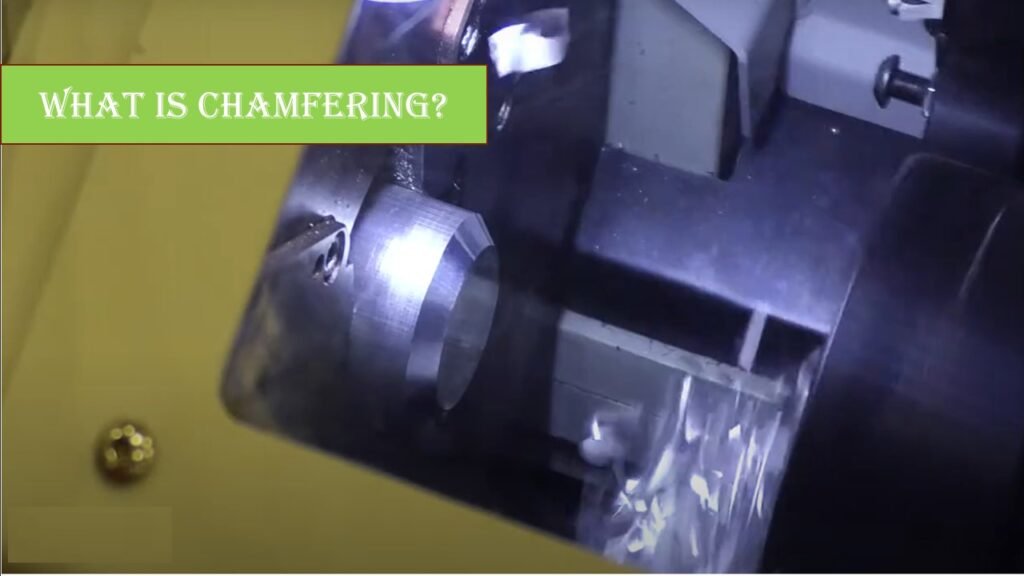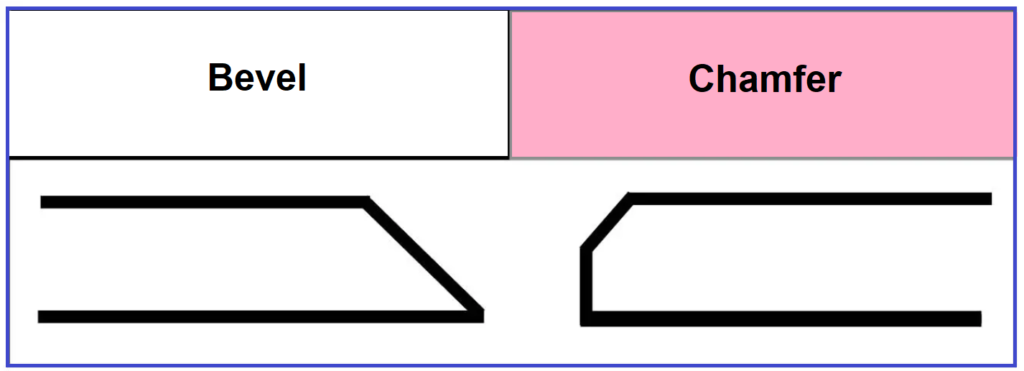In everyday language, the terms “bevel” and “chamfer” are often used interchangeably, although there are subtle technical distinctions. A chamfer typically refers to a beveled edge that connects two surfaces. In the context of deburring, chamfering is a valuable tool.

What is Chamfer or Chamfering?
A chamfer is a transitional edge that occurs between two adjoining faces of an object. It’s often created at a 45° angle between two right-angled faces, although other angles can be used depending on the specific application.
Chamfers have a wide range of applications across various fields:
- Machining: In machining, chamfers are used to “ease” sharp edges, making them safer and less prone to damage. This is important for both safety reasons and to prevent wear and tear on the edges of machined parts.
- Carpentry: Chamfers are commonly used in carpentry and woodworking to create smooth and aesthetically pleasing transitions between edges. They also serve practical purposes, such as preventing splintering.
- Furniture Making: In furniture-making, a specific type of chamfer known as a “lark’s tongue” is used. This chamfer ends in a gradual outward curve, leaving the remainder of the edge as a right angle. It’s a design element that adds both style and functionality.
- Concrete Formwork: Chamfers are used in concrete formwork to create beveled edges on concrete structures. These edges improve the appearance of the finished concrete and make it easier to remove the formwork.
- Mirrors: Chamfered edges are common in mirrors, providing a polished and attractive look while also reducing the risk of chipping.
- Mechanical Engineering: Chamfers are often employed in mechanical engineering designs to facilitate assembly and reduce stress concentrations at sharp corners, which can lead to material failure.
It’s important to note that while the terms “chamfer” and “bevel” are sometimes used interchangeably, in machining, “bevel” typically refers to a specific type of angled edge preparation, whereas a chamfer is a more general term for transitional edges created by removing material at an angle. Additionally, a “fillet” is a rounding-off of an interior corner, and a “round” or “radius” refers to the rounding of an exterior corner. Each of these features serves distinct purposes in design and manufacturing.
Let’s Explain into a more technical explanation of chamfering:
Chamfering is a machining operation that involves the removal of material to create a beveled edge or surface at an angle other than 90 degrees (a right angle). This angle, known as the chamfer angle, can vary widely based on the application and engineering specifications. Common chamfer angles include 45 degrees, 30 degrees, or custom angles as required.

Tools and Methods: Chamfering can be performed using various tools and methods, depending on the material being worked on and the precision required:
- Hand Tools: For manual chamfering, hand tools such as files, rasps, abrasive stones, or deburring tools can be used to remove material and create the desired chamfer.
- Machine Tools: In machining processes, machine tools like chamfer mills, countersinks, or countersinking tools are employed to create chamfers with high precision. These tools can be mounted on milling machines, lathes, or dedicated chamfering machines.
- Abrasive Wheels: Grinding wheels or abrasive belts can also be used to chamfer edges. This method is often applied in large-scale production environments.
Applications of Chamfering:
- Manufacturing and Metalworking: Chamfering is common in metalworking, where it’s used to prepare edges for welding, reduce stress concentrations, and improve the appearance of machined parts. It’s crucial in applications such as aerospace, automotive, and general engineering.
- Woodworking: In woodworking, chamfering is used to ease sharp corners on furniture, cabinetry, or decorative moldings. It enhances the aesthetics and safety of wooden objects.
- Plastics and Composites: Chamfering is essential in the fabrication of plastic parts and composite materials. It prevents stress cracks, ensures proper fit during assembly, and enhances the finished appearance.
- Construction: In construction, chamfering is applied to concrete edges, particularly in architectural concrete work, to create visually appealing and safer edges.
Benefits of Chamfering:
- Safety: Chamfered edges are less prone to causing injuries as they lack sharp, jagged corners.
- Strength and Durability: Chamfering can reduce stress concentrations that might lead to material failure, improving the durability of parts.
- Assembly and Fit: Chamfered edges can simplify the assembly of parts, promoting better fits and reducing the need for forceful adjustments.
- Aesthetics: Chamfering enhances the visual appeal of objects by giving them a more refined, finished appearance.
In summary, chamfering is a versatile machining technique used across various industries to create beveled edges, improve safety, enhance structural integrity, and refine the appearance of objects, components, and materials. The specific chamfering method and angle are chosen based on the material, application, and engineering requirements.